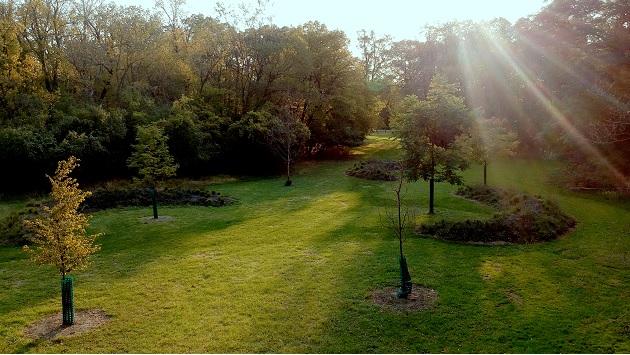Cultural and Ecological Stewardship Along the Des Plains Trail
Forest Preserve Foundation focuses on restoring the land, developing Native American education in greater Chicago

Within Schiller Woods, in the Forest Preserves of Cook County, rests the Serpent Twin Mound (Pokto Činto), a contemporary earthwork by Indigenous artist and architect Santiago X.
It’s believed to be the first effigy mound built by Native Americans in North America in the past 500 years.
Erected near the shores of the Des Plaines River, just four miles east of O’Hare International Airport in Cook County, the earthwork is a tribute to an ancient form of wayfinding used by Indigenous people of the region hundreds of years ago.
Following tradition, the mound is constructed of soil and indigenous plants. When the Schiller Woods mound was installed in 2019, it was expected that the composition of plants would change over time.
But within just a few years, invasive species like Canada thistle overran the area and overtook the native plants, explains Debra Walker Johnson, president of the Forest Preserve Foundation—the philanthropic arm covering 70,000 acres of urban forest preserves in Cook County.
“We wanted to clear the invasive plants that threatened that particular area and to control any type of regrowth,” she says.
When Enbridge heard about the invasive plants overtaking Schiller Woods, we wanted to help return the space to its natural habitat. Enbridge’s Fueling Futures program supports sustainability projects that help improve, grow and nurture our environment, and our $20,000 Fueling Futures donation to the Forest Preserve Foundation has helped with the removal of invasive species—and the addition of 40,000 native plants, including tallgrass and wildflowers.
Restoring the land will “better reflect pre-settlement ecology,” says Walker Johnson, noting that the restoration project at Schiller Woods strikes a unique balance between ecological and cultural stewardship.
“We will restore the ancient beauty of this land, while helping people understand its cultural and historical significance,” she says.
Part of Enbridge’s funding will help the foundation develop community programming to share the stories and culture of the Indigenous people of the region.
Foundation staff are working with the American Indian Center of Chicago, the oldest urban Native American center in the United States, to develop educational opportunities.
A paddling program is planned to launch this fall. People of all ages will be invited to paddle from the serpent mound in Schiller Woods to its twin, a coiled serpent, nine miles downriver in Honer Park. Along the way, participants will learn the stories of the land and the people who lived there since time immemorial.
“As a forest preserve, we shelter and harbor a lot of important cultural history,” explains Michelle Uting, the foundation’s grant administrator. “We all need to understand the history of this country and how it came to be, including the impacts of colonialism.”
Uting notes that the programming will cover the past and present experiences of Indigenous people.
“We so often talk about Indigenous communities in the past when they’re very much here with us in the present,” she says. “These serpent mounds are reminders that Indigenous people are here today with us. They’re present. They're going into the future with us.”

